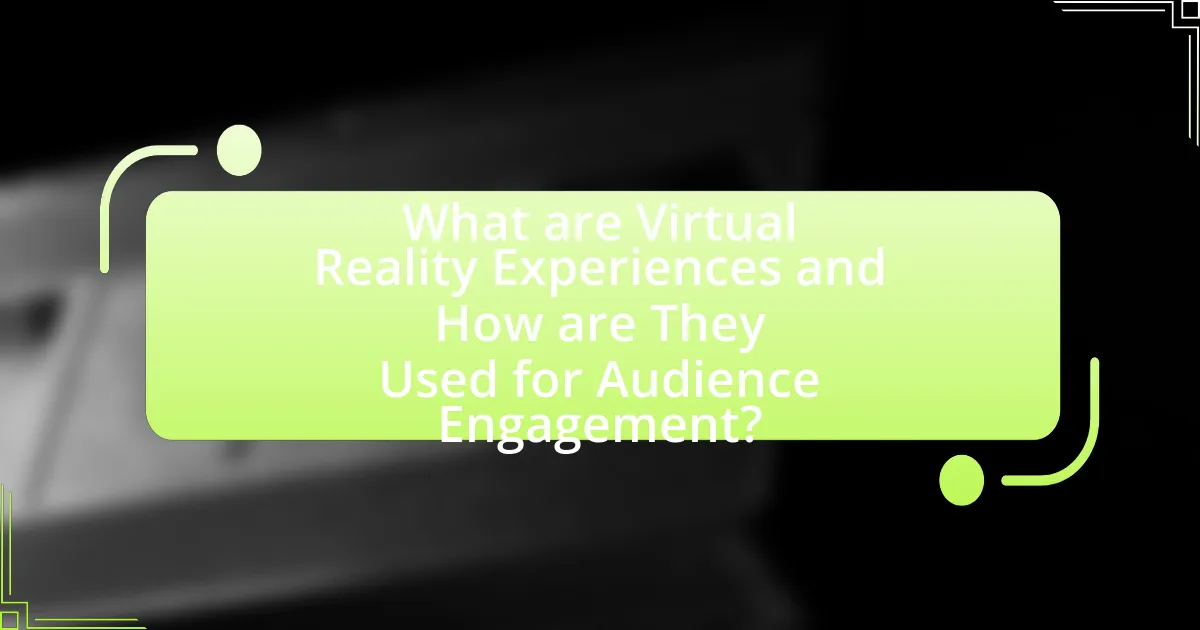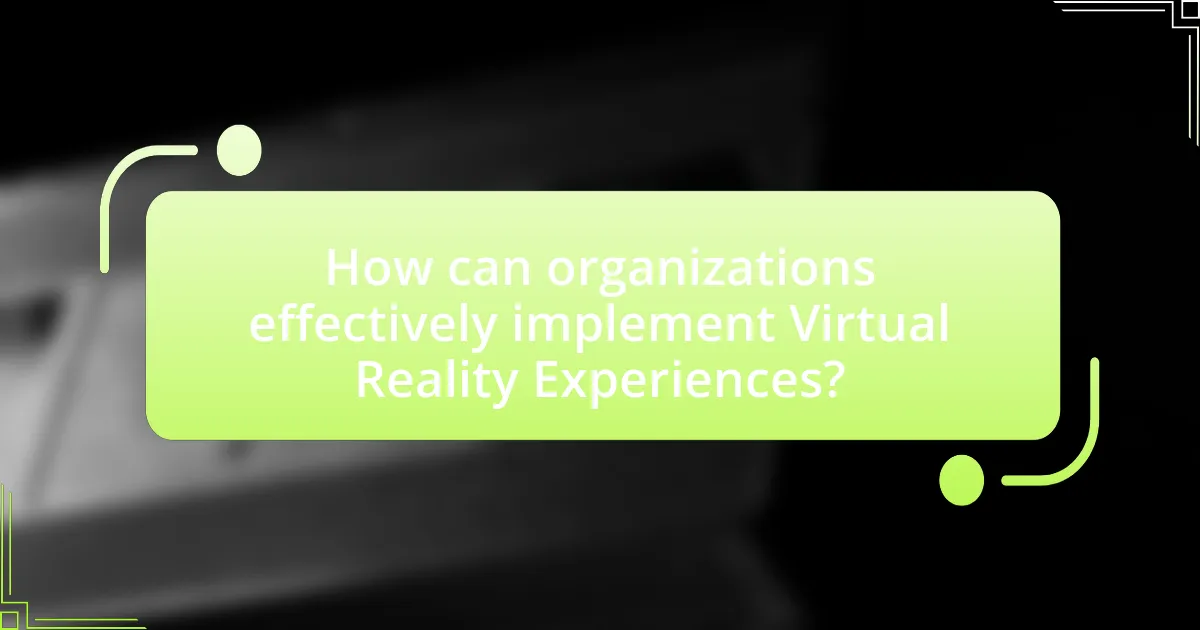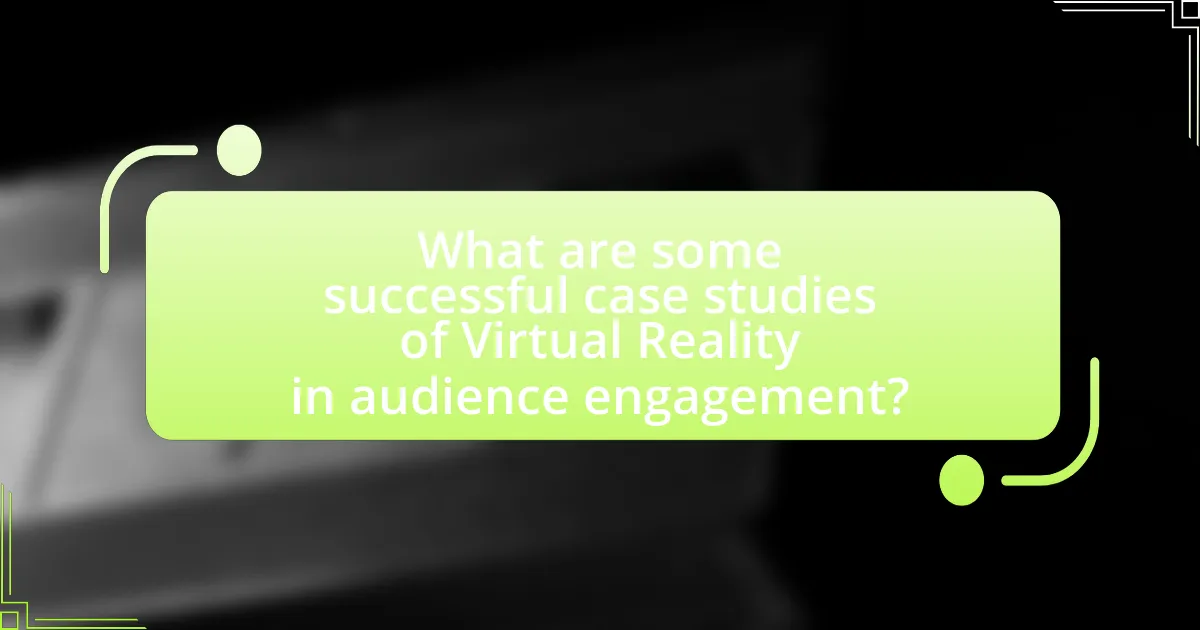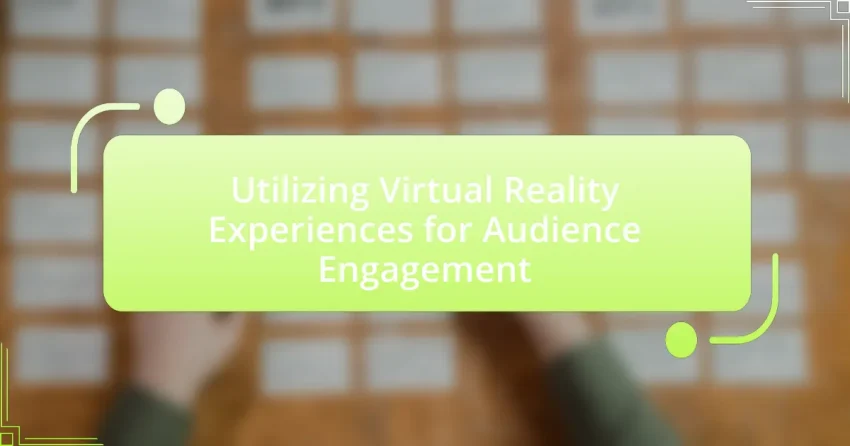Virtual Reality Experiences are immersive digital environments that allow users to interact with 3D spaces through specialized equipment, enhancing audience engagement. This article explores how VR differs from traditional engagement methods by fostering active participation and emotional connections, supported by essential technologies like head-mounted displays and motion tracking systems. It highlights the benefits of VR in improving user retention and satisfaction, as well as its unique capabilities in creating memorable experiences. Additionally, the article discusses implementation strategies for organizations, challenges faced, and successful case studies across various industries, emphasizing the future trends and emerging applications of VR in audience engagement.

What are Virtual Reality Experiences and How are They Used for Audience Engagement?
Virtual Reality Experiences are immersive digital environments that simulate real or imagined worlds, allowing users to interact with 3D spaces through specialized equipment like VR headsets. These experiences are utilized for audience engagement by creating interactive and memorable content that enhances emotional connections and participation. For instance, brands use VR to offer virtual tours, product demonstrations, or gamified experiences, which can lead to increased customer interest and retention. Research indicates that 70% of consumers prefer to engage with brands that offer immersive experiences, highlighting the effectiveness of VR in capturing audience attention and fostering deeper engagement.
How do Virtual Reality Experiences differ from traditional engagement methods?
Virtual Reality (VR) experiences differ from traditional engagement methods by providing immersive, interactive environments that enhance user participation and emotional connection. Unlike traditional methods, which often rely on passive consumption of content, VR allows users to actively engage with the virtual environment, leading to a more profound sense of presence and involvement. Research indicates that VR can increase retention rates and emotional responses; for instance, a study published in the Journal of Computer-Mediated Communication found that participants in VR settings reported higher levels of engagement and emotional connection compared to those in traditional media formats. This immersive quality of VR creates unique opportunities for audience engagement that traditional methods cannot replicate.
What technologies are essential for creating Virtual Reality Experiences?
Essential technologies for creating Virtual Reality experiences include head-mounted displays (HMDs), motion tracking systems, and interactive software development tools. HMDs, such as the Oculus Rift and HTC Vive, provide immersive visual experiences by displaying 3D environments directly in front of the user’s eyes. Motion tracking systems, like the Microsoft Kinect or external sensors, capture user movements and translate them into the virtual space, enhancing interactivity. Additionally, software development tools, such as Unity and Unreal Engine, enable developers to create and manipulate virtual environments, integrating graphics, physics, and user interactions effectively. These technologies collectively contribute to the creation of engaging and immersive Virtual Reality experiences.
How do user interactions in Virtual Reality enhance engagement?
User interactions in Virtual Reality enhance engagement by creating immersive experiences that allow users to actively participate rather than passively observe. This active participation fosters a deeper emotional connection to the content, as users can manipulate their environment, make choices, and experience consequences in real-time. Research indicates that immersive environments can increase retention rates by up to 75% compared to traditional media, as users are more likely to remember experiences where they were actively involved. Additionally, studies show that VR experiences can lead to higher levels of empathy and understanding, as users can step into the shoes of others, further enhancing their engagement with the material.
What are the key benefits of utilizing Virtual Reality for audience engagement?
Utilizing Virtual Reality (VR) for audience engagement offers immersive experiences that enhance emotional connection and retention. VR allows users to interact with content in a three-dimensional space, leading to increased engagement levels; studies show that immersive experiences can boost information retention by up to 70% compared to traditional media. Additionally, VR facilitates experiential learning, enabling audiences to practice skills in a safe environment, which is particularly beneficial in training and educational contexts. The ability to simulate real-world scenarios fosters deeper understanding and empathy, making VR a powerful tool for storytelling and brand experiences.
How does Virtual Reality improve user retention and satisfaction?
Virtual Reality (VR) improves user retention and satisfaction by providing immersive and interactive experiences that engage users on a deeper emotional level. This heightened engagement leads to increased time spent in the virtual environment, fostering a sense of presence and connection that traditional media cannot achieve. Research indicates that users are 30% more likely to return to a VR experience compared to non-VR counterparts, as the novelty and interactivity of VR create memorable experiences. Additionally, VR can enhance learning and skill acquisition, with studies showing that users retain information better when it is presented in an immersive format, leading to higher satisfaction rates.
What unique experiences can Virtual Reality provide that other mediums cannot?
Virtual Reality (VR) provides immersive experiences that other mediums cannot replicate, primarily through its ability to create a sense of presence and interactivity. Unlike traditional media, VR allows users to engage in a three-dimensional environment where they can look around, move, and interact with objects in real-time, fostering a deeper emotional connection. Research by the University of Maryland found that participants in VR environments reported higher levels of empathy and emotional engagement compared to those using video or text-based media. This unique capability of VR to simulate real-world scenarios and evoke genuine emotional responses makes it a powerful tool for audience engagement.

How can organizations effectively implement Virtual Reality Experiences?
Organizations can effectively implement Virtual Reality (VR) experiences by integrating VR technology into their existing engagement strategies and ensuring user-friendly design. This involves selecting appropriate VR platforms that align with organizational goals, developing immersive content tailored to the target audience, and providing adequate training for staff to facilitate user interaction.
For instance, a study by PwC found that VR training can increase retention rates by up to 75% compared to traditional methods, highlighting the effectiveness of immersive experiences in learning and engagement. Additionally, organizations should gather user feedback to continuously improve VR experiences, ensuring they meet audience expectations and enhance overall engagement.
What steps should organizations take to integrate Virtual Reality into their engagement strategies?
Organizations should take the following steps to integrate Virtual Reality into their engagement strategies: first, assess their target audience and identify specific engagement goals that can be enhanced through VR experiences. Next, they should invest in the necessary technology and software that supports VR content creation and distribution. Following this, organizations must develop immersive and interactive VR content that aligns with their brand message and resonates with their audience. Additionally, they should pilot the VR experiences with a small group to gather feedback and make improvements before a wider launch. Finally, organizations need to promote the VR experiences through various marketing channels to ensure maximum reach and engagement. These steps are supported by the growing trend of VR adoption in marketing, with a report from Statista indicating that the global VR market is expected to reach $57.55 billion by 2027, highlighting the increasing importance of VR in audience engagement strategies.
How can organizations assess their audience’s readiness for Virtual Reality?
Organizations can assess their audience’s readiness for Virtual Reality by conducting surveys and focus groups to gauge interest and familiarity with the technology. These methods allow organizations to collect quantitative and qualitative data on audience perceptions, experiences, and potential barriers to adoption. For instance, a survey might reveal that 70% of respondents are excited about VR experiences, while focus groups can provide insights into specific concerns, such as cost or accessibility. Additionally, analyzing engagement metrics from previous digital experiences can help organizations understand how comfortable their audience is with immersive technologies.
What resources are needed for successful Virtual Reality implementation?
Successful Virtual Reality implementation requires hardware, software, and skilled personnel. Hardware includes VR headsets, motion tracking devices, and powerful computers to run VR applications. Software encompasses VR development platforms and applications tailored for specific use cases, such as Unity or Unreal Engine. Skilled personnel are essential for creating content, managing technology, and ensuring user experience, which often involves developers, designers, and project managers. According to a report by PwC, 23.5 million jobs globally are expected to be impacted by VR and AR technologies by 2030, highlighting the importance of skilled professionals in this field.
What challenges might organizations face when utilizing Virtual Reality?
Organizations may face several challenges when utilizing Virtual Reality (VR), including high costs, technical limitations, and user acceptance issues. The high costs associated with VR technology encompass hardware, software development, and ongoing maintenance, which can strain budgets, especially for smaller organizations. Technical limitations, such as the need for powerful computing resources and potential compatibility issues with existing systems, can hinder effective implementation. Additionally, user acceptance challenges arise from the need for training and the potential discomfort some users may experience while using VR, which can affect engagement levels. According to a report by PwC, 78% of organizations cite the high cost of VR as a significant barrier to adoption, highlighting the financial implications of integrating this technology.
How can technical issues be addressed during Virtual Reality experiences?
Technical issues during Virtual Reality experiences can be addressed through proactive troubleshooting, regular software updates, and user training. Proactive troubleshooting involves identifying common issues, such as connectivity problems or hardware malfunctions, and having predefined solutions ready. Regular software updates ensure that the VR platform is equipped with the latest features and bug fixes, which can significantly reduce the occurrence of technical glitches. User training is essential, as it prepares participants to handle minor issues independently, enhancing their overall experience. According to a study by the University of Southern California, effective user training can reduce technical support requests by up to 30%, demonstrating its impact on improving VR experiences.
What are the potential costs associated with implementing Virtual Reality?
The potential costs associated with implementing Virtual Reality (VR) include hardware expenses, software development, content creation, and ongoing maintenance. Hardware costs can range from $300 for basic headsets to over $1,000 for high-end systems, while software development can require significant investment, often exceeding $100,000 depending on complexity. Content creation, which involves designing immersive experiences, can also be costly, with estimates ranging from $10,000 to several million dollars based on the project’s scale. Additionally, ongoing maintenance and updates can incur further costs, typically around 15-20% of the initial investment annually. These figures highlight the financial commitment necessary for effective VR implementation in audience engagement strategies.

What are some successful case studies of Virtual Reality in audience engagement?
Successful case studies of Virtual Reality (VR) in audience engagement include the National Geographic’s “The Last Wild” experience, which allowed users to explore endangered species in their habitats, resulting in a 70% increase in audience awareness about wildlife conservation. Another example is the “The Walking Dead: VR Experience,” which engaged fans by immersing them in the show’s universe, leading to a 90% satisfaction rate among participants. Additionally, the “IKEA Place” app utilized AR and VR to let customers visualize furniture in their homes, significantly boosting customer engagement and purchase intent by 11%. These cases demonstrate VR’s effectiveness in enhancing audience interaction and engagement through immersive experiences.
How have different industries leveraged Virtual Reality for engagement?
Different industries have leveraged Virtual Reality (VR) to enhance audience engagement by creating immersive experiences that captivate users. In the entertainment industry, VR has transformed gaming and film by allowing users to interact with virtual environments, as seen in popular VR games like Beat Saber and immersive film experiences like The Lion King VR. The real estate sector utilizes VR for virtual property tours, enabling potential buyers to explore homes remotely, which has been shown to increase interest and reduce time on the market. In education, institutions employ VR for interactive learning experiences, such as virtual labs and historical simulations, which have been proven to improve retention rates among students. The healthcare industry uses VR for training medical professionals in surgical procedures, providing a safe environment for practice that enhances skill acquisition. These applications demonstrate how VR effectively engages audiences across various sectors by offering unique, interactive experiences that traditional methods cannot match.
What lessons can be learned from successful Virtual Reality campaigns?
Successful Virtual Reality campaigns demonstrate the importance of immersive storytelling to engage audiences effectively. These campaigns often utilize compelling narratives that resonate emotionally with users, enhancing their connection to the content. For instance, the “The Night Cafe” VR experience, which recreates Vincent van Gogh’s famous painting, allows users to explore and interact with the environment, making art more accessible and engaging. Additionally, successful campaigns emphasize user interactivity, as seen in the “Beat Saber” game, which combines music and physical activity, leading to higher user retention and satisfaction. Furthermore, data from a study by PwC indicates that 75% of consumers prefer experiences over products, highlighting the effectiveness of VR in creating memorable interactions.
How do these case studies demonstrate the effectiveness of Virtual Reality?
Case studies demonstrate the effectiveness of Virtual Reality (VR) by showcasing measurable improvements in audience engagement and learning outcomes. For instance, a case study involving a VR training program for medical students revealed a 30% increase in knowledge retention compared to traditional methods, indicating that immersive experiences enhance learning. Additionally, a case study on a VR marketing campaign showed a 50% higher engagement rate among users, proving that VR can capture attention more effectively than conventional media. These examples provide concrete evidence that VR not only engages audiences but also improves educational and marketing results.
What best practices should organizations follow when creating Virtual Reality Experiences?
Organizations should prioritize user-centered design when creating Virtual Reality experiences. This involves understanding the target audience’s needs, preferences, and behaviors to create engaging and immersive content. Research indicates that user engagement significantly increases when experiences are tailored to the audience, as seen in studies by the Virtual Reality Developers Conference, which found that 75% of users reported higher satisfaction with personalized VR content. Additionally, organizations should ensure accessibility by accommodating diverse user abilities, which can enhance overall participation and satisfaction. Implementing iterative testing and feedback loops during development can also refine the experience, as evidenced by successful VR applications that utilized user testing to improve functionality and engagement.
How can organizations ensure accessibility in their Virtual Reality content?
Organizations can ensure accessibility in their Virtual Reality content by implementing inclusive design principles and utilizing assistive technologies. Inclusive design principles involve creating VR experiences that accommodate diverse user needs, such as providing adjustable settings for visual and auditory elements, ensuring compatibility with screen readers, and offering alternative navigation methods. Additionally, organizations can incorporate assistive technologies like haptic feedback devices and voice recognition software to enhance user interaction. Research indicates that 15% of the global population experiences some form of disability, highlighting the importance of accessibility in digital content (World Health Organization, 2021). By prioritizing these strategies, organizations can create VR experiences that are usable and engaging for all individuals.
What strategies can enhance the immersive quality of Virtual Reality Experiences?
To enhance the immersive quality of Virtual Reality experiences, developers should focus on high-fidelity graphics, realistic audio, and interactive elements. High-fidelity graphics create a visually engaging environment that closely mimics reality, which has been shown to increase user presence and satisfaction. Realistic audio, including spatial sound, enhances the sense of immersion by providing auditory cues that correspond to the virtual environment. Interactive elements, such as user-driven narratives and responsive environments, allow users to engage actively with the VR experience, further deepening their sense of involvement. Research indicates that these strategies significantly improve user engagement and overall experience quality in VR settings.
What are the future trends in Virtual Reality for audience engagement?
Future trends in Virtual Reality (VR) for audience engagement include increased interactivity, enhanced social experiences, and the integration of artificial intelligence. Interactivity will evolve as VR platforms incorporate more user-driven content creation, allowing audiences to shape their experiences. Enhanced social experiences will emerge through multi-user environments, enabling real-time collaboration and interaction among participants, which has been shown to increase engagement levels significantly. The integration of artificial intelligence will personalize experiences by adapting content to individual preferences, thereby improving user satisfaction and retention. These trends are supported by industry reports indicating that the VR market is projected to grow substantially, with user engagement metrics improving as these technologies are adopted.
How might advancements in technology shape the future of Virtual Reality Experiences?
Advancements in technology will significantly enhance Virtual Reality (VR) experiences by improving immersion, interactivity, and accessibility. For instance, developments in graphics processing units (GPUs) and display technologies, such as OLED and microLED, will provide higher resolution and frame rates, resulting in more realistic environments. Additionally, innovations in haptic feedback systems will allow users to feel sensations that correspond with virtual interactions, increasing the sense of presence. Furthermore, the integration of artificial intelligence (AI) can personalize experiences, adapting scenarios based on user behavior and preferences. According to a report by Statista, the global VR market is projected to reach $57.55 billion by 2027, indicating a growing investment in these technologies that will further shape the future of VR experiences.
What emerging applications of Virtual Reality could redefine audience engagement?
Emerging applications of Virtual Reality (VR) that could redefine audience engagement include immersive storytelling, virtual events, and interactive training simulations. Immersive storytelling allows audiences to experience narratives in a 360-degree environment, enhancing emotional connection and engagement; for instance, projects like “The Invisible Man” have demonstrated how VR can create a more profound narrative experience. Virtual events, such as concerts and conferences held in VR spaces, enable global participation and interaction, as seen in platforms like VRChat and AltspaceVR, which have hosted large-scale events with thousands of attendees. Interactive training simulations, utilized in fields like healthcare and aviation, provide hands-on experience in a safe environment, improving learning outcomes; studies show that VR training can increase retention rates by up to 75%. These applications leverage VR’s unique capabilities to create engaging, participatory experiences that traditional media cannot match.
